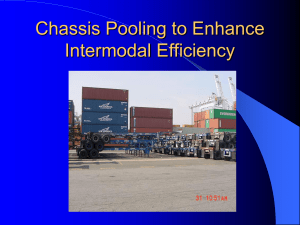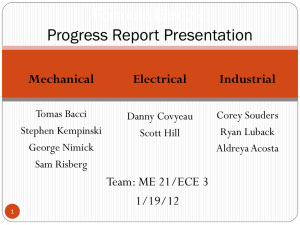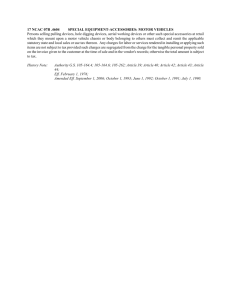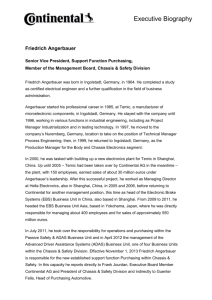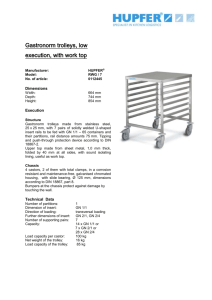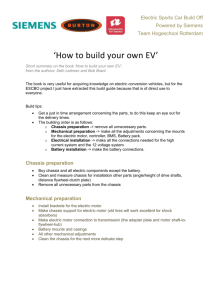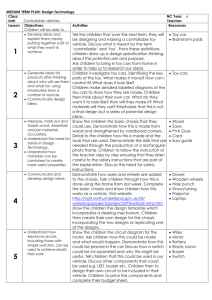A Gap in the Market - International Asset Systems
advertisement
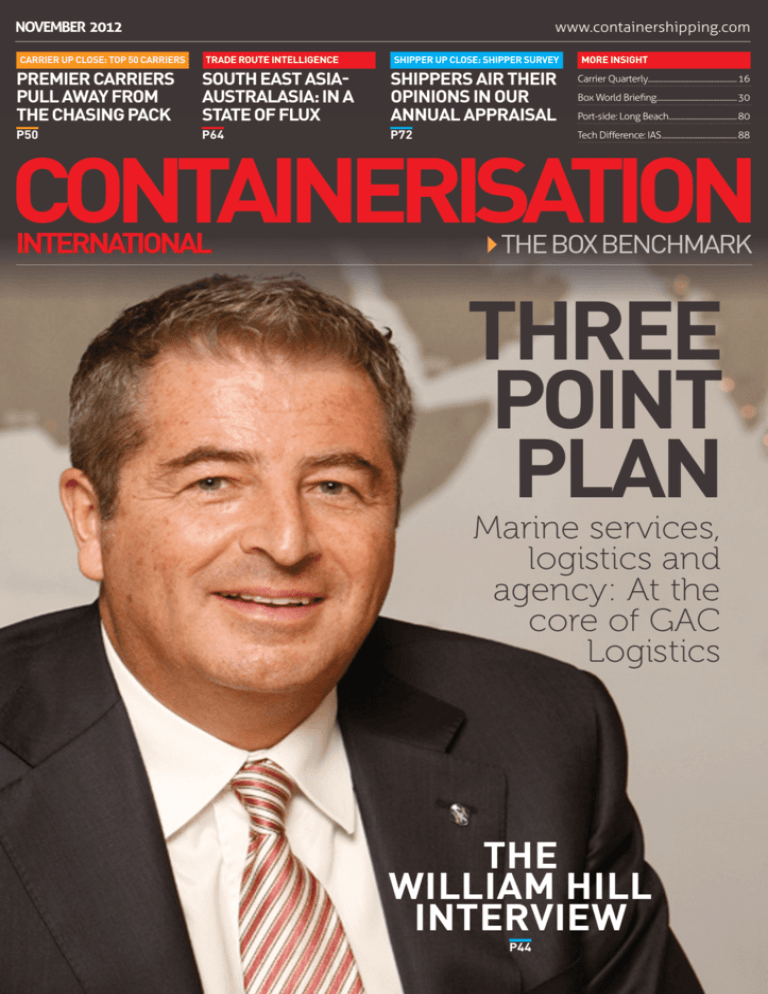
NOVEMBER 2012 CARRIER UP CLOSE: TOP 50 CARRIERS www.containershipping.com TRADE ROUTE INTELLIGENCE SHIPPER UP CLOSE: SHIPPER SURVEY PREMIER CARRIERS PULL AWAY FROM THE CHASING PACK SOUTH EAST ASIAAUSTRALASIA: IN A STATE OF FLUX SHIPPERS AIR THEIR OPINIONS IN OUR ANNUAL APPRAISAL P50 P64 P72 MORE INSIGHT Carrier Quarterly....................................................16 Box World Briefing...............................................30 Port-side: Long Beach........................................80 Tech Difference: IAS............................................88 THREE POINT PLAN Marine services, logistics and agency: At the core of GAC Logistics THE WILLIAM HILL INTERVIEW P44 THE TECH DIFFERENCE IAS/CHASSISMANAGER A GAP IN THE MARKET The decision of ocean carriers to withdraw from the US chassis market has provided opportunities for other players, and International Asset System has launched its ChassisManager to help the situation. Rebecca Moore reports O Chris Mazza: IAS’ solution addresses equipment availability DATA HUB • Ocean carriers quitting the chassis market include: APL, Maersk Line, OOCL, Evergreen, Hapag-Lloyd and NYK Line • ChassisManager modules include event management, pre-billing and invoicing and collection • The Hampton Roads Chassis Pool currently uses it • IAS is planning to develop a forecasting component 88 CONTAINERISATION INTERNATIONAL n the back of the fundamental changes and resulting uncertainty taking place in the provision of chassis in US ports, transport/freight software specialist International Asset Systems (IAS) has launched a new product aimed at helping trucking companies, ocean carriers and shippers deal with the situation. The traditional model in which ocean carriers owned/rented their own chassis on which to store and then distribute their containers is being replaced by truckers and/or lessors of managed pools fulfilling this role. ChassisManager was launched in September and its development has come at a pertinent time for the industry as many ocean carriers have phased out their chassis in key ports and inland areas. In August, for instance, APL rolled-out a new third-party business model in Denver and Salt Lake City while Hapag-Lloyd, Maersk Line, OOCL, NYK Line, Evergreen, Yang Ming, Hyundai Merchant Marine (HMM), CMA CGM and niche transatlantic liner Atlantic Container Line (ACL) have all retired from chassis ownership in selected areas. Chris Mazza, senior vice president of business development at IAS, highlighted the benefits of moving to a motor carrier provisioning model: ‘Ocean carriers understand that the motor carrier will use the chassis more efficiently than it would as it is able to consistently use the chassis on a daily basis and is very engaged in managing and repairing it. www.containershipping.com ‘Ocean carriers know a significant portion of their chassis fleet is idle at any given time and the new model will improve utilisation and efficiency for all stakeholders. It aligns the US with the rest of the world.’ Nevertheless, despite the benefits there is definitely a gap in the market for a service to help smooth the transition process, according to Mazza. He explained: ‘The transition faces difficulties as ocean carriers are all doing things differently. Even though chassis are a critical component in the intermodal supply chain for containerised cargo, many motor carriers and other chassis users do not know what to expect in terms of equipment availability, prices, and exceptions in the new chassis provisioning model. Our ChassisManager solution addresses these issues.’ The solution has been launched in conjunction with its first customer, Hampton Roads Chassis Pool (HRCP). IAS is also in discussions with other companies, including ocean carriers, about the use of the model. HRCP will leverage ChassisManager to streamline motor carrier registration procedures, to enable pre-bill reviews, dispute resolutions, invoicing and rental payments. Safe, seamless and smooth transition 'As the ocean carriers engage in the new chassis provisioning model, we have collaborated with IAS to ensure a safe, seamless and smooth transition,’ said Art Ellermann, general manager of HRCP. ‘ChassisManager meets the needs of our valued November 2012 NEXT MONTH: CHGHG HGHGHHTEMS THE TECH DIFFERENCE IAS/CHASSISMANAGER ChassisManager means that all parties can work together as good partners.’ While many ocean carriers are exiting the direct provisioning of chassis, it is still an important part of the market for them and they will continue to pay for chassis or provide them for their customers. However, it is likely that there will be an increase in the number of BCOs wanting to establish direct links with drayage companies for their cargo transfers. Screenshot of IAS’ software ‘Our solution means that all the invoices and charging structures are shown in a timely manner (real time) and in clear and easy to understand formats’ CHALLENGES • Confusion reigns as ocean carriers have different exit strategies • Lack of transparency when it comes to invoicing • Linking up all the different parties – such as carriers and truckers – involved in the market • Accurately calculating chassis demand SOLUTIONS • ChassisManager addresses equipment availability, prices and exceptions • Invoices and charging structures are shown in real time, so both parties can see them clearly • Different constituencies involved in the provision of chassis can register and communicate with each other • Deriving better forecasting techniques 90 CONTAINERISATION INTERNATIONAL motor carrier partners and provides services as the chassis model changes.’ The functionality included in the new software includes: • Chassis user registration and administration – this establishes and enforces chassis user acceptance criteria and business rules. It also allows integration with industry-specific insurance compliance clearing houses. • Event management – it receives data from the chassis pools as equipment is accepted and/or released. It also generates exception reports to monitor compliance and allows for better levels of billing accuracy. • Pre-billing and invoicing – this generates invoices to motor carriers for their use of chassis; stores rates, billing rules, and billable events while offering integration with chassis owners' systems. The module also incorporates pre-bill functionality that enables motor carriers to dispute incorrect underlying activity rather than charges on generated invoices. • Collections – accepts payments using ACH, credit cards or other commonly accepted methods; provides on-line invoice resolution; tracks collection efforts. ChassisManager utilises IAS’ current cloud platform, which forms the basis of its Dispatch suite of software. The platform is shared by thousands of trucking/drayage companies, meaning that there is already a ready base for the ChassisManager e-solution to be widely implemented. All parts of the supply chain are able to use the new software, from the providers of the chassis, to the companies arranging the provision of the assets (usually motor carriers, but sometimes beneficial cargo owners (BCOs) who directly work with motor carriers to make arrangements). Mazza elaborated: ‘The benefits are that all the different constituents involved in the provision of chassis can register on ChassisManager and communicate with each other. As ocean carriers exit the market, they can plan – via ChassisManager – how to effectively rent chassis to motor carriers should they wish to do so. ‘Alternatively ChassisManager allow chassis providers (such as leasing companies, chassis pool managers and chassis investors) to also rent chassis to motor carriers and ensure there is always a ready supply of equipment to meet customers’ requirements. The use of www.containershipping.com Invoicing made easy An important aspect of the new software is the ability to invoice. ‘A big issue is the invoicing for the use of the chassis as ocean carriers operate different systems,’ said Mazza. ‘Our solution means that all the invoices and charging structures are shown in a timely manner (real time) and in clear and easy to understand formats. Truckers can download all the charges they receive and then generate invoices for shippers.’ He noted that without such a system, chassis invoices are processed manually, which adds costs and takes more time. Highlighting another important advantage of using the system, Mazza said: ‘Motor carriers are given a clear view via the system where the chassis are picked up from and where they are dropped off. This gives them network connectivity and allows them to clearly see their usage of the asset.’ This aspect is one which IAS wants to develop further. ‘Eventually, we want to increase the forecasting aspect of the software. This will mean adding more to the supply side of the calculations, so that demand can be calculated beforehand and so that the chassis provider knows when and where demand is likely to be greatest,’ he said. ‘Clarity on daily chassis supply and demand on a location basis remains a challenge.’ Mazza suggested this could help deal with ‘dislocation’ shortages, whereby there might be five different pick-up locations in a single port, but the majority of chassis are congregated in the wrong location. He explained: ‘With better forecasting, chassis providers can reposition equipment in the areas where they are most needed. At the moment, forecasting is historical as it is based on looking backwards, which is not the most effective way, it would be more effective if forecasting was based on looking forward.’ The ChassisManager platform is based on a subscription ‘pay as you go’ model. Asked whether there was any competition within software providers to fill the chassis gap, Mazza argued: ‘I don’t really see any direct competition. We are the only true SAP provider of such a solution.’ After the decision by Maersk to sell its DCLI Direct Chassis Link, it seems there will be an even greater push for the change in the chassis model, as Mazza said: ‘Our impression is that the market will accelerate, especially with the sale of the DCLI.’ Therefore, it looks like solutions like ChassisManager will be in even greater demand next year. ■ November 2012

